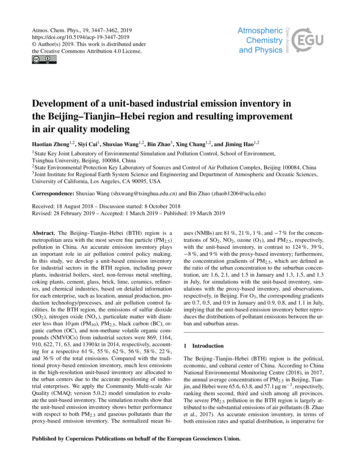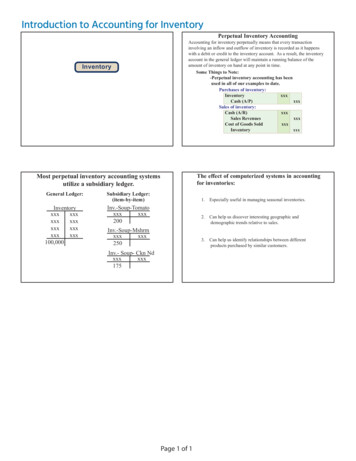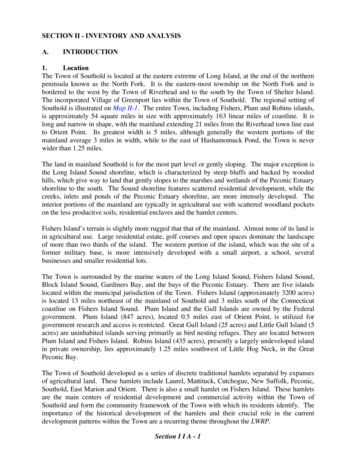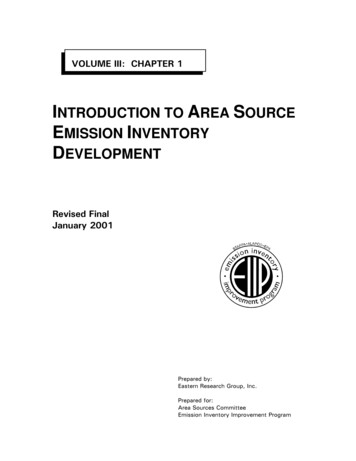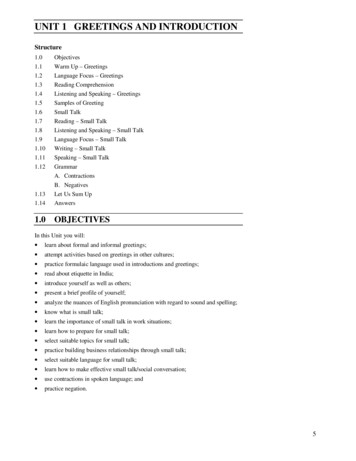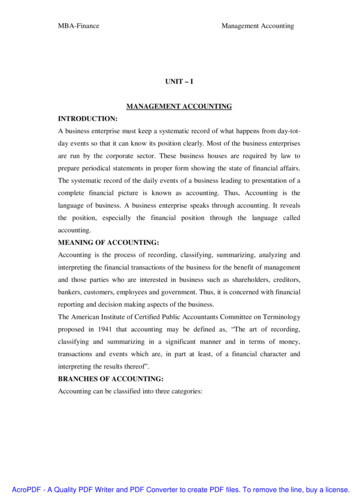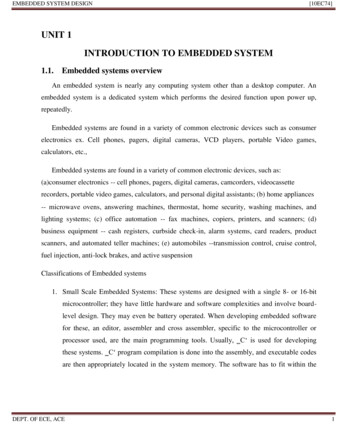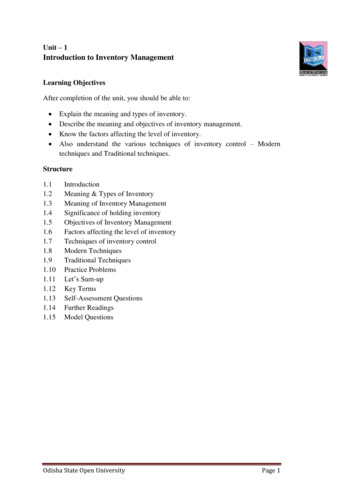
Transcription
Unit – 1Introduction to Inventory ManagementLearning ObjectivesAfter completion of the unit, you should be able to: Explain the meaning and types of inventory.Describe the meaning and objectives of inventory management.Know the factors affecting the level of inventory.Also understand the various techniques of inventory control – Moderntechniques and Traditional 01.111.121.131.141.15IntroductionMeaning & Types of InventoryMeaning of Inventory ManagementSignificance of holding inventoryObjectives of Inventory ManagementFactors affecting the level of inventoryTechniques of inventory controlModern TechniquesTraditional TechniquesPractice ProblemsLet’s Sum-upKey TermsSelf-Assessment QuestionsFurther ReadingsModel QuestionsOdisha State Open UniversityPage 1
1.1IntroductionA business can run smoothly its operating activities only when appropriateamount of inventory is maintained. Inventory affects all operating activities likemanufacturing, warehousing, sales etc. The amount of opening inventory andclosing inventory should be sufficient enough so that the other business activitiesare not adversely affected. Thus, inventory plays an important role in operationsmanagement.1.2Meaning & Types of InventoryInventory is an asset that is owned by a business that has the express purpose ofbeing sold to a customer. Inventory refers to the stock pile of the product a firm isoffering for sale and the components that make up the product. In other words, theinventory is used to represent the aggregate of those items of tangible assets whichare – Held for sale in ordinary course of the business. In process of production for such sale. To be currently consumed in the production of goods or services to beavailable for sale.The inventory may be classified into three categories: Raw material and supplies: It refers to the unfinished items which go inthe production process. Work in Progress: It refers to the semi-finished goods which are not 100%complete but some work has been done on them. Finished goods: It refers to the goods on which 100% work has been doneand which are ready for sale.1.3Meaning of Inventory ManagementInventory management is the practice overseeing and controlling of the ordering,storage and use of components that a company uses in the production of the itemsit sells. A component of supply chain management, inventory managementsupervises the flow of goods from manufacturers to warehouses and from theseOdisha State Open UniversityPage 2
facilities to point of sale. Inventory control means efficient management of capitalinvested in raw materials and supplies, work- in – progress and finished goods.1.4Significance of holding inventoryInventory is considered to be one of the most important assets of a business. Itsmanagement needs to be proactive, accurate and efficient. Inventory is essentialfor every organization to ensure smooth running of the production process, toreduce the ordering cost of inventory, to take advantage of quantity discount,avoid opportunity loss on sales, to utilize and optimize the plant capacity and toreduce the overall price. Thus, it can be said that inventory is inevitable and has tobe maintained in appropriate quantity. However, the concept of Just In Time (JIT)is becoming popular which is an inventory strategy companies employ to increaseefficiency and decrease waste by receiving goods only as they are needed in theproduction process, thereby reducing inventory costs. This method requiresproducers to forecast demand accurately.1.5Objectives of Inventory ManagementThe objective of inventory management is to maintain inventory at an appropriatelevel to avoid excess or shortage of inventory. Inventory management systemsreduce the cost of carrying inventory and ensure that the supply of raw materialand finished goods remains continuous throughout the business operations. Theobjectives specifically may be divided into two categories mentioned below:A. Operating objectives: They are related to the operating activities of thebusiness like purchase, production, sales etc.a. To ensure continuous supply of materials.b. To ensure uninterrupted production process.c. To minimize the risks and losses incurred due to shortage ofinventory.d. To ensure better customer services.e. Avoiding of stock out danger.Odisha State Open UniversityPage 3
B. Financial Objectives:a. To minimize the capital investment in the inventory.b. To minimize inventory costs.c. Economy in purchase.Apart from the above objectives, inventory management also emphasize to bringdown the adverse impacts of holding excess inventory. Holding excess inventorylead to the following consequences: Unnecessary investment of funds and reduction in profit. Increase in holding costs. Loss of liquidity. Deterioration in inventory. Check your progressExercise 1Suppose you are the inventory manager of a firm dealing in dairy products. Statewhat would be your priority objectives of managing the inventory of dairyproducts. .1.6Factors affecting the level of inventoryThe level of inventory should be appropriate. The appropriateness of the amountof inventory depends upon a number of factors. Some significant factors affectingthe level of inventory are explained as follows:1. Nature of business: The level of inventory will depend upon the nature ofbusiness whether it is a retail business, wholesale business, manufacturingbusiness or trading business.Odisha State Open UniversityPage 4
2. Inventory turnover: Inventory turnover refers to the amount of inventorywhich gets sold and the frequency of its sale. It has a direct impact on theamount of inventory held by a business concern.3. Nature of type of product: The product sold by the business may be aperishable product or a durable product. Accordingly, the inventory has tobe maintained.4. Economies of production: The scale on which the production is done alsoaffects the amount of inventory held. A business may work on large scalein order to get the economies of production.5. Inventory costs: More the amount of inventory is held by the business,more will be the operating cost of holding inventory. There has to be atrade-off between the inventory held and the total cost of inventory whichcomprises of purchase cost, ordering cost and holding cost.6. Financial position: Sometimes, the credit terms of the supplier are rigidand credit period is very short. Then, according the financial situation ofthe business the inventory has to be held.7. Period of operating cycle: If the operating cycle period is long, then themoney realization from the sale of inventory will also take a long duration.Thus, the inventory managed should be in line with the working capitalrequirement and the period of operating cycle.8. Attitude of management: The attitude and philosophy of top managementmay support zero inventory concept or believe in maintaining hugeinventory level. Accordingly, the inventory policy will be designed for thebusiness.1.7Techniques of inventory controlInventory control refers to a process of ensuring that appropriate amount of stockare maintained by a business, so as to be able to meet customer demand withoutdelay while keeping the costs associated with holding stock to a minimum.Inventory control signifies a planned approach of finding when to shift, what toshift, how much to shift and how much to stock so that costs in buying and storingare optimally minimum without interrupting production or affecting sales. Tosolve these problems of inventory management various techniques are there.Odisha State Open UniversityPage 5
These techniques are divided into two categories – modern techniques andtraditional techniques.(1) MODERN TECHNIQUES(a) Economic Order Quantity (EOQ)(b) Re-Order Point (ROP)(c) Fixing Stock Levels(d) Selective Inventory Control(i) ABC Analysis(ii) VED Analysis(iii) SDE Analysis(iv) FSN Analysis(2) TRADITIONAL TECHNIQUES(a)Inventory Control Ratios(b) Two Bin System(c)Perpetual Inventory System(d) Periodic Order System1.8Modern TechniquesModern techniques of inventory control refers to those techniques which areevolved through a scientific process. These techniques involve the use of aformula or a method which is logically derived to keep control on the inventorylevels. These techniques are explained as below:(a) ECONOMIC ORDER QUANTITY (EOQ)The optimal size of an order for replenishment of inventory is called economicorder quantity. Economic order quantity (EOQ) or optimum order quantity is thatsize of the order where total inventory costs (ordering costs carrying costs) areOdisha State Open UniversityPage 6
minimized. Economic order quantity can be calculated from any of the followingtwo methods: Formula MethodGraphic MethodFormula Method: It is also known as ‘SQUARE ROOT FORMULA’ or‘WILSON FORMULA’ as given below:EOQ 2ROCWhere, EOQ Economic Order QuantityR Annual Requirement or consumption in unitsO Ordering Cost per orderC Carrying Cost per unit per yearNo. of orders R/EOQTime gap between two orders No. of days in a year/No. of ordersTotal Cost Purchase Cost Carrying Cost Order Cost (R x Unit Price) (EOQ/2 x C) (R/EOQ x O)Graphic MethodThe economic order quantity can also be determined with the help of graph.Under this method, ordering costs, carrying costs and total inventory costsaccording to different lot sizes are plotted on the graph. The intersection point atwhich the inventory carrying cost and the ordering cost meet, is the economicorder quantity. At this point the total cost line is also minimum.YEOQTotal Inventory CostCarrying CostCostOrdering CostOOdisha State Open UniversityXPage 7
Assumptions: The following assumptions are made: The rate of consumption of inventory is assumed to be constant. Costs will not change over time. Lead time is assumed to be known and constant. Per order cost, carrying cost and unit price are constant. Carrying or holding costs are proportionate to the value of stock held. Ordering cost varies proportionately with the price.(b) RE-ORDER POINTAfter determining the optimum quantity of purchase order, the next problem is tospecify the point of time when the order should be placed. Re-order level is thatlevel of inventory at which an order should be placed for replenishing the currentstock of inventory. The determination of re-order point depends upon the leadtime, usage rate and safety stock. These terms are explained below:1. Lead Time: Lead time refers to the time gap between placing the orderand actually receiving the items ordered.2. Usage Rate: It refers to the rate of consumption of raw material per day.Usage Rate Total annual consumption / No. of days in ayear3. Safety Stock: It is the minimum quantity of inventory which a firmdecides to maintain always to protect itself against the riskand losses likely to occur due to stoppage in productionand loss of sale, due to non- availability of inventory.Formulae:Re Order Point (Lead Time x Usage Rate) Safety StockorRe Order Point Maximum usage x Maximum Re Order PeriodSafety Stock Usage Rate x Days of safetyUsage Rate Annual Consumption/No. of days in a year.Odisha State Open UniversityPage 8
(c) Fixing Stock LevelsFixing of the stock levels is necessary to avoid increased cost on account of highinventory levels and to avoid loss of sales or stoppage of production due to lowlevel of inventory. Therefore, efforts should be made to keep the inventory levelwithin the specified minimum and maximum limits. The maximum & minimumstock levels are fixed after considering the following factors: Availability of ample storage space. Lead time involved i.e. time required in receiving the goods ordered. Availability of working capital to meet the routine expenses. Average rate of consumption of material Cost of storage and insurance of inventory. Risk of obsolescence and deterioration of the inventory. Economy in prices such as making bulk purchases during period of lowprices. Re-order level.FormulaeMaximum Level (ROL ROQ) – (Minimum Usage x Minimum Re OrderPeriod) or Maximum Level Safety Stock EOQMinimum Level Re-order level – (Normal Usage Rate x Normal Re-orderperiod) Re Order Level – (Normal Usage x Average ReOrder Period)Average stock level (Maximum level Minimum level) / 2orAverage stock level (Minimum level 1/2 Re- order Quantity)Odisha State Open UniversityPage 9
Note: ROL – Re Order LevelROQ – Re Order QuantityROQ is also known as EOQ (Economic Order Quantity)DANGER LEVELDanger level refers to the level below the minimum stock level. The followingfactors should be considered to determine the danger level: Causes for failure of regular supplies Easy and quick sources of supply Rescheduling of work- order in the light of such exigencies Quickest means of transportation Emergency period of procurementFormulaDanger Level Minimum rate of consumption x Emergency delivery period.Danger Level Maximum rate of consumption x Emergency delivery period.(d) SELECTIVE INVENTORY CONTROLControlling all inventory in the stock is a very difficult task especially where hugeinventories are maintained of variety of items. In such circumstances, followingsmart techniques for managing and controlling the different types of inventoriesheld are as follows:(i)ABC Analysis: ABC analysis may be defined as a technique whereinventories are analyzed with respect to their value so that costly itemsare given greater attention and care by the management. Threecategories are created namely A, B and C. Following table representsthe approximate classification of items along with their value andquantity.Odisha State Open UniversityPage 10
Category%ofTotal% of ii)VED Analysis:VED stands for Vital, Essential and Desirable.Highest control is over vital items, medium control is exercised overessential items and least control is inferred over desirable items.(iii)SDE Analysis: SDE stands for Scarce, Difficult and Easy. Highestcontrol is over scarce items, medium control is exercised over difficultitems and least control is inferred over easily available items.(iv)FSN Analysis: FSN stands for Fast Moving (F), Slow Moving (S) andNon Moving (N). Highest control is kept over fast moving items,medium control is exercised over slow moving items and least controlis inferred on non-moving items. Check your progressExercise 2According to you which selective inventory technique is most appropriate to beapplied for inventory control? State reasons to support your answer. .Odisha State Open UniversityPage 11
1.9Traditional TechniquesTraditional techniques refers to those techniques which are prevalent before theevolution of the modern techniques. These techniques were derived with theworking practice and are based on experience and ease of usage by the workersand the small business enterprises. These techniques are explained as follows:(a) INVENTORY CONTROL RATIOSRatios related to inventory are calculated and further used as a measure of control.Stock Turnover Cost of goods sold / Average Stock(b) TWO BIN SYSTEMUnder two bin system, all the inventory items are stored in two separate bins. Binmeans container of any size. In the first bin, a sufficient amount of inventory iskept to meet the current requirement over a designated period of time. In thesecond bin, a safety stock is maintained for use during lead time. When the stockof first bin is completely used, an order for further stock is immediately placed.The material in second bin is then consumed to meet stock needs until the neworder is received. On receipt of new order, the stock used from the second bin isrestored and the balance is put in the first bin. Therefore, depletion of inventory inthe first bin provides an automatic signal to re-order. Thus, this technique istraditional yet logical and can be used by illiterate workers also without using anyformula.Re-orderLevelLead TimeSafety BufferStockRe-orderPointBIN IOdisha State Open UniversityBIN IIPage 12
(c) PERPETUAL INVENTORY SYSTEMPerpetual inventory system is defined as the method of recording stores balanceafter each receipt and each issue to facilitate regular checking of inventory. It isalso known as continuous stock checking. The application of perpetual inventorycontrol system involves –(i)Attaching bin cards with bins.(ii)Continuous stock taking to compare the actual stock.Bin cards refers to the cards attached to every bin in which the details regardingthe quantity of material received, issued and balance left in that bin is recordedhand to hand. Under this system, statement of material, follow up actions,monitoring etc. can be smoothly carried out.(d) PERIODIC ORDER SYSTEMUnder this system, the stock levels of all types of inventories held, are reviewedafter a fixed time interval. Time interval may be weekly, fortnightly, monthly,quarterly etc. depending upon the criticality of the item. Critical items may requirea short review cycle and on the other hand, lower cost and non-moving items mayrequire long review cycle. Therefore, for different items different time intervalsshould be used. After the review, the items which are less than the required level,order is placed to replenish their exhausted level. Check your progressExercise 3Which techniques of inventory control are better – traditional techniques ormodern techniques? Give reasons to support your answer. .Odisha State Open UniversityPage 13
1.10Practice ProblemsQ.1. Calculate the economic order quantity from the following particulars:Annual requirement 2,000 unitsCost of materials per unit Rs. 20Cost of placing and receiving one order Rs. 40Annual carrying cost of inventory, 20% of inventory value.Solution: Here, R 2,000O 40Unit Price 20C 20% of Unit Price 20% of 20 4EOQ 2RO / C 2(2000)(40) / (4) 200 unitsQ.2. Compute EOQ and the total variable cost from the following information:Annual demand 4,000 unitsUnits Price Rs. 40Order Cost Rs. 20Storage Rate 7% Per annumInterest Rate 3% Per annumSolution: Here, R 4,000O 20Unit Price 40C 10% of Unit Price 10% of 40 4EOQ 2RO / C Odisha State Open University 2(4000)(20) / (4) 200 unitsPage 14
Total Variable Cost Carrying Cost Order Cost (EOQ/2 x C) (R/EOQ x O) (200/2 x 4) (4000/200 x 20) 400 400 Rs. 800Total Cost Purchase Cost Carrying Cost Order Cost(R x Unit Price) (EOQ/2 x C) (R/EOQ x O) (4000 x 40) (200/2 x 4) (400
1.3 Meaning of Inventory Management 1.4 Significance of holding inventory 1.5 Objectives of Inventory Management 1.6 Factors affecting the level of inventory 1.7 Techniques of inventory control 1.8 Modern Techniques 1.9 Traditional Techniques 1.10 Practice Problems 1.11 Let’s Sum-up 1.12


